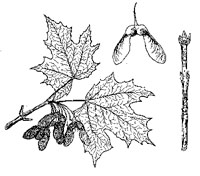Traditionally,
March is the month when galvanized buckets begin to appear hanging on the
sides of stately sugar maples. In recent years, clear plastic tubes
running in long webs from tree to tree have begun to replace the old
methods. Either way, the goal is to collect the sweet sap from the tree to
be boiled down to that wonderful maple syrup for our pancakes.
In the autumn, deciduous trees such as the maple send
sugars
from their leaves down into the roots to be stored for the winter.
This provides the energy to produce the first set of leaves the following
spring to renew the growth cycle. In March, when the days are warm but the
nights are still cool, the stored sugars are sent back up the tree.
 Over the centuries, people discovered that the sap of
the sugar maple is especially sweet. By
drilling a hole through the bark
and into the vascular system of the tree, we can interrupt the flow and
direct it into buckets. Timing is important since the flow only lasts a
few weeks.
Over the centuries, people discovered that the sap of
the sugar maple is especially sweet. By
drilling a hole through the bark
and into the vascular system of the tree, we can interrupt the flow and
direct it into buckets. Timing is important since the flow only lasts a
few weeks.
 Although
several species of maple may be used for syrup production, the sugar maple
(Acer saccharum) and the black maple (A. nigrum) provide the
best production. The amount of sap that can be safely taken from a tree
without causing damage is a judgment call. If the previous growing season
included major stresses such as a serious drought, trees may be short on
the vital energy needed to sustain themselves. In this case, the tapping
season should be shortened to avoid further stresses on the tree.
Although
several species of maple may be used for syrup production, the sugar maple
(Acer saccharum) and the black maple (A. nigrum) provide the
best production. The amount of sap that can be safely taken from a tree
without causing damage is a judgment call. If the previous growing season
included major stresses such as a serious drought, trees may be short on
the vital energy needed to sustain themselves. In this case, the tapping
season should be shortened to avoid further stresses on the tree.
 The
sap itself contains only about 2 percent sugar. That is why it must be
boiled down and concentrated into the sticky, slow flowing syrup. It takes
approximately 43 gallons of sap to produce one gallon of syrup. That is
one reason that the pure stuff is relatively expensive.
The
sap itself contains only about 2 percent sugar. That is why it must be
boiled down and concentrated into the sticky, slow flowing syrup. It takes
approximately 43 gallons of sap to produce one gallon of syrup. That is
one reason that the pure stuff is relatively expensive.
If you are really into this topic, you might want to
order a copy of the North American
Maple Syrup Producers Manual.
This 178 page publication covers every aspect of maple syrup production.
It is available from:
The Ohio State University
Publications Office
385 Kottman Hall
2021 Coffey Rd.
Columbus, OH 43210-1044